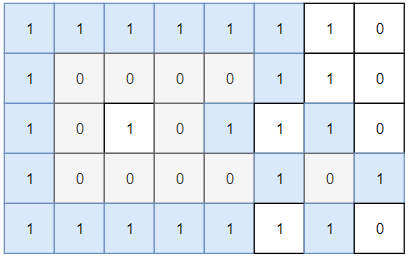1、原题描述:
Given a 2D grid consists of 0s (land) and 1s (water). An island is a maximal 4-directionally connected group of 0s and a closed island is an island totally (all left, top, right, bottom) surrounded by 1s.
Return the number of closed islands.
Example 1:
Input: grid = [[1,1,1,1,1,1,1,0],[1,0,0,0,0,1,1,0],[1,0,1,0,1,1,1,0],[1,0,0,0,0,1,0,1],[1,1,1,1,1,1,1,0]] Output: 2 Explanation: Islands in gray are closed because they are completely surrounded by water (group of 1s).
Example 2:
Input: grid = [[0,0,1,0,0],[0,1,0,1,0],[0,1,1,1,0]] Output: 1
Example 3:
Input: grid = [[1,1,1,1,1,1,1],
[1,0,0,0,0,0,1],
[1,0,1,1,1,0,1],
[1,0,1,0,1,0,1],
[1,0,1,1,1,0,1],
[1,0,0,0,0,0,1],
[1,1,1,1,1,1,1]]
Output: 2
Constraints:
1 <= grid.length, grid[0].length <= 1000 <= grid[i][j] <=1
2、简要翻译:
0代表地面,1代表 水,数不与边界相连的岛屿数(上下左右 算相连)
3、代码思路:
广度优先搜索遍历全图,时间复杂度O(mn)
4、Java解题代码:
private static final int[][] directions = {{0, 1}, {1, 0}, {0, -1}, {-1, 0}}; public int closedIsland(int[][] grid) { int m = grid.length; int n = grid[0].length; int[][] visited = new int[m][n]; boolean flag; LinkedList<int[]> queue = new LinkedList<>(); int result = 0; for (int i = 1; i < m - 1; i++) { for (int j = 1; j < n - 1; j++) { if (grid[i][j] == 0 && visited[i][j] == 0) { flag = true; queue.addLast(new int[]{i, j}); int[] island; int I, J; while (!queue.isEmpty()) { island = queue.pollFirst(); for (int[] direction : directions) { I = island[0] + direction[0]; J = island[1] + direction[1]; if (I >= 0 && I < m && J >= 0 && J < n && grid[I][J] == 0 && visited[I][J] == 0) { visited[I][J] = 1; queue.addLast(new int[]{I, J}); if (I == 0 || I == m - 1 || J == 0 || J == n - 1) { flag = false; } } } } if (flag) result++; } } } return result; }

